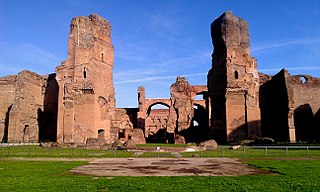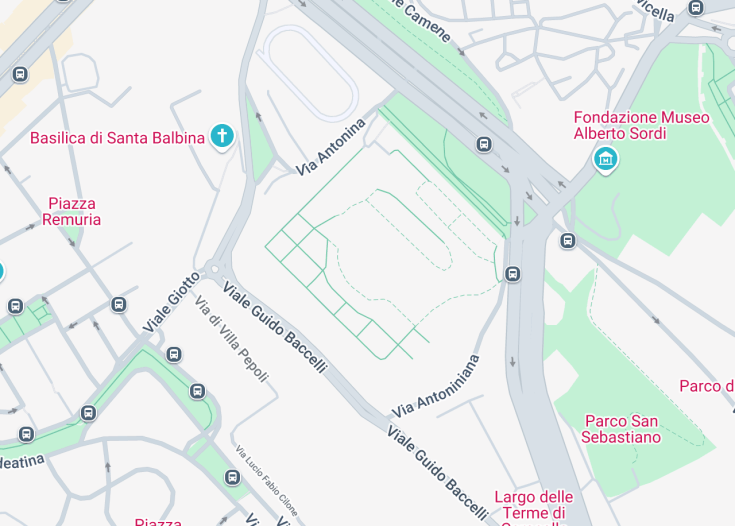The Baths of Caracalla, an extraordinary archaeological site in Rome, Italy, exemplifies the grandeur of ancient Roman engineering and architecture. Constructed in the early 3rd century AD, these public baths served as a cultural hub, combining leisure, socializing, and hygiene in a magnificent setting laden with mosaics and sculptures.
To enhance your experience at the Baths of Caracalla, consider visiting early in the morning. This not only minimizes crowds but also allows you to appreciate the serene beauty and scale of the ruins without distraction.
For those planning their journey to the Baths of Caracalla, it is advisable to wear comfortable shoes, as the site covers a significant area that requires ample walking. Additionally, bringing a camera to capture the stunning architecture and art is highly recommended.
Baths of Caracalla: A Marvel of Ancient Roman Engineering
The Baths of Caracalla, located in the heart of Rome, Italy, are a stunning testament to the grandeur of ancient Roman architecture and engineering. Constructed between 212 and 216 AD under Emperor Caracalla, these monumental public baths were not only a place for bathing but also a social hub for Romans. Covering an area of 13 hectares, the baths featured a complex of hot, warm, and cold rooms, along with lush gardens, libraries, and shops. Visitors can explore the vast, well-preserved ruins that still echo the opulence of imperial Rome, offering insights into the daily life and culture of ancient Romans. The Baths of Caracalla are a UNESCO World Heritage site, making them a must-visit for tourists seeking to immerse themselves in the rich history of the Eternal City. The sheer scale and intricate mosaics add to the experience, providing a glimpse into the luxurious lifestyle enjoyed by the citizens of ancient Rome. Whether you’re an architecture enthusiast or a history buff, the Baths of Caracalla promise an unforgettable adventure.
Exploring the Wonders of the Baths of Caracalla
Visitors to the Baths of Caracalla can enjoy a variety of attractions and activities. One of the main highlights is wandering through the immense ruins that illustrate the sophistication of Roman engineering. Don’t miss the hypocaust, the ancient heating system that warmed the floors.
Relax in the Gardens
You can also take a leisurely stroll in the surrounding gardens, which provide a serene space for reflection amidst the historical remnants.
Mosaics and Frescoes
Admiring the remaining mosaics and frescoes offers a glimpse into the artistic prowess of the time. Regular guided tours are available, offering in-depth historical knowledge and context about this impressive site.
Evening Events
Occasionally, the baths host cultural events, such as concerts and art exhibitions, enhancing the enchanting experience of the site.
Did You Know? The Baths’ Unique Construction Techniques
An interesting fact about the Baths of Caracalla is their use of innovative construction techniques, showcasing the advanced engineering capabilities of the Romans. The massive concrete structure employed in constructing the baths allowed for grand open spaces and vaulted ceilings that weren’t seen elsewhere at the time. Additionally, the baths featured an elaborate system of water supply and drainage, essential for maintaining hygiene. This ingenuity not only played a crucial role in daily public bathing but also established the Baths of Caracalla as a revolutionary model for future bathhouses throughout the Roman Empire and beyond.
Discover the Magnificent Baths of Caracalla in Rome, Italy
The Baths of Caracalla stand as one of the most impressive ancient sites in the Eternal City, drawing visitors into a world of Roman luxury and grandeur. Built between AD 212 and 216 under Emperor Caracalla, this sprawling complex was more than just a place for bathing; it was a social and cultural hub for Roman citizens, showcasing the architectural prowess of the time. Visitors to the Baths of Caracalla can expect to be amazed by the remnants of this vast spa, which once featured epic marble work, intricate mosaics, and grand halls that housed hot baths, warm baths, and cold baths. Today, the ruins provide an intriguing insight into Roman engineering and daily life, making it a perfect site for both history buffs and casual tourists alike. As you wander through the expansive grounds, you’ll see the remains of stunning vaulted ceilings, lush gardens, and ancient stone pathways that create a sense of stepping back in time. The baths were ideal places for social interactions, and even today visitors can sense the whispers of history in the air. For those planning to visit, it’s worth noting that the Baths of Caracalla can be easily integrated into a broader itinerary. Nearby attractions include the Colosseum, Palatine Hill, and the Roman Forum, all accessible within walking distance. This makes it a great stop on a full day of exploring ancient Rome. To enhance your experience, consider purchasing a combined ticket that allows entry to multiple sites, potentially saving both time and money.
Optimal Times to Experience the Baths of Caracalla
The best times to visit the Baths of Caracalla are during the early morning or late afternoon when the light softens the ruins’ features, creating stunning photography opportunities. Weekdays tend to be less crowded compared to weekends, allowing visitors to experience the ambiance more intimately.
Annual Events and Special Opportunities
Each summer, the Baths of Caracalla host a renowned opera festival, bringing the ancient venue to life with music and performances. This is a unique opportunity to enjoy a cultural event in a historic setting, offering an unforgettable experience.
Accessibility and Visitor Limitations
While the Baths of Caracalla are open to the public, certain accessibility limitations exist. The site has uneven terrain, which can make it challenging for those with mobility issues.
Accessibility
Limitations
- Food and drink are not permitted inside the archaeological site.
- Certain areas may be closed for maintenance or restoration.
- Large bags and backpacks must be checked at the entrance.
Notes to visitors
- Respect the ancient ruins and do not climb on structures.
- Photography is allowed; however, tripods and professional equipment require prior permission.
- Audio guides are available, providing enriching insights into the site’s history.
General Information
Details for your visit to Baths of Caracalla
Location
The Baths of Caracalla are situated close to iconic landmarks like the Colosseum and the Circus Maximus, making it an easily accessible stop. Visitors can seamlessly integrate this ancient marvel into their sightseeing journey.
Address:
Viale delle Terme di Caracalla, 00153 Roma RM, ItalyVisiting Information
The Baths of Caracalla are typically open throughout the week, allowing visitors to explore the site at their convenience. The best time of day for an optimal experience is during the morning hours, when the site is less crowded and the lighting enhances the beauty of the ancient ruins.
How to Reach the Baths of Caracalla
Reaching the Baths of Caracalla is straightforward from various points in the city.
Car
The Baths can be accessed easily by car, with nearby parking facilities available for a nominal fee. This option offers flexibility but may come with traffic delays depending on the time of day.
| Route | Distance | Travel time |
|---|---|---|
| From Termini Station | 2 miles (3.2 km) | 10 minutes |
| From Vatican City | 3 miles (5 km) | 15 minutes |
| From Trastevere | 1 mile (1.6 km) | 5 minutes |
Public Transportation
Using public transportation to reach the Baths is also efficient. Visitors can take the Metro Line B to the Circo Massimo station, followed by a short walk to the entrance.
| Route | Travel time |
|---|---|
| From Termini Station (Metro) | 15 minutes |
| From Vatican City (Bus) | 25 minutes |
| From Trastevere (Bus) | 15 minutes |
Nearby Attractions
- Colosseum – 0.8 miles (1.3 km)
- Palatine Hill – 0.7 miles (1.2 km)
- Roman Forum – 0.9 miles (1.5 km)
- Circo Massimo – 0.2 miles (0.3 km)
- Arco di Costantino – 0.6 miles (1 km)
- Basilica di San Clemente – 1 mile (1.6 km)
- Palazzo delle Esposizioni – 1.2 miles (1.9 km)
- National Museum of Rome – 1.3 miles (2.1 km)
- Teatro di Marcello – 1.1 miles (1.8 km)
- Santa Maria in Cosmedin – 1 mile (1.6 km)
- Jewish Ghetto – 1.4 miles (2.3 km)
- Pantheon – 1.6 miles (2.6 km)
Common Questions
What is the history of the Baths of Caracalla?
What are the architectural features of the Baths of Caracalla?
- Size and Structure: The baths covered approximately 13 acres, showcasing grand dimensions that exemplified the importance of baths in Roman society.
- Vaulted Ceilings: The massive vaulted ceilings reached heights of 40 feet or more, supported by intricate archways that offered both strength and elegance.
- Mosaics and Decorations: The interiors were adorned with stunning mosaics depicting mythological scenes, geometric patterns, and floral motifs, which added to the baths’ luxurious atmosphere.
- Heating System: The complex featured a sophisticated hypocaust system, an engineering marvel that allowed for underfloor heating, ensuring the water remained at the desired temperatures.
- Water Supply: The baths were supplied with water from the nearby Aqua Marcia aqueduct, showcasing the advanced Roman aqueduct systems.
These architectural features not only served practical purposes but also demonstrated the grandeur of the Roman Empire’s commitment to public wellness and leisure.
What facilities were available at the Baths of Caracalla?
- Caldarium: This was the hot bath area, featuring steaming water heated by a complex hypocaust system, creating a warm and relaxing ambiance.
- Tepidarium: The warm bath room served as a transition area, where visitors could acclimatize before moving to the hotter caldarium or the cooler frigidarium.
- Frigidarium: A cool plunge bath, this room provided a refreshing experience, allowing bathers to cool down after exposure to heat.
- Gymnasium: Facilities for exercise and physical activities were part of the complex, promoting fitness and a healthy lifestyle.
- Libraries and Gardens: Spaces for relaxation and study were included, reflecting the importance of intellectual pursuits alongside physical well-being.
These amenities emphasized the social and cultural significance of public baths in Roman life, serving as a communal meeting space for relaxation and leisure.
What did the Baths of Caracalla symbolize in ancient Roman society?
- Public Health and Hygiene: The baths emphasized the Romans’ commitment to cleanliness and public health, providing a communal space for bathing that was central to daily life.
- Social Interaction: These facilities were not just places for bathing; they served as social hubs where people from various walks of life could gather, interact, and engage in discussions, reinforcing social bonds.
- Imperial Power and Grandeur: Commissioned by Emperor Caracalla, the baths showcased the emperor’s wealth and authority, demonstrating the power of Rome. Such monumental structures were a means of projecting imperial identity and pride.
- Cultural and Intellectual Pursuits: The inclusion of libraries and areas for physical activity encouraged both mental and physical well-being, indicating a society that valued education and fitness.
- Architectural Innovation: The scale and craftsmanship of the baths illustrated Rome’s advanced engineering techniques and architectural achievements, influencing future construction and design.
In essence, the Baths of Caracalla encapsulate the ideals of Roman civilization, blending health, social life, and imperial grandeur in a single monumental complex.
What is the significance of the artwork found in the Baths of Caracalla?
- Artistic Mastery: The mosaics and sculptures within the baths display the intricate skills of Roman artists. They feature complex designs, vibrant colors, and detailed representations of mythological scenes, showcasing the high standards of artistry in ancient Rome.
- Cultural Expressions: The themes depicted in the artwork often revolve around mythology, daily life, and nature, reflecting the cultural values, beliefs, and aesthetics of the time.
- Socio-Political Commentary: Certain pieces of art may serve to reinforce the social order or illustrate the power and divine connection of the emperor, providing commentary on political dynamics in Roman society.
- Preservation of History: These artworks allow modern scholars and archaeologists to understand the cultural and historical context of ancient Rome, including their religious beliefs and societal norms.
- Influence on Future Art: The artistic styles and techniques found in the Baths of Caracalla would go on to influence later artistic movements and styles, illustrating the continuity and evolution of artistic expression through the ages.
Overall, the artwork in the Baths of Caracalla serves as a vital legacy, illustrating the richness of Roman culture and its enduring impact on art history.

Are the Baths of Caracalla in Rome, Italy worth visiting?
The Baths of Caracalla are among the most significant ancient ruins in Rome, showcasing the grandeur of Roman engineering and culture. Spanning over 25 acres, these baths are a testament to the luxurious lifestyle of the ancient Romans. Visitors can explore the extensive remains of elegant mosaics, towering columns, and impressive structures that once served as a social hub. While the Baths of Caracalla might not feel as intimate as other sites, their sheer scale and historical importance make them a worthwhile stop for tourists. However, expect to spend time wandering through vast spaces that can feel a bit empty. Be prepared for crowds, especially in peak season. Overall, this site offers a unique glimpse into Rome’s opulent past, making it a strong addition to any itinerary.









